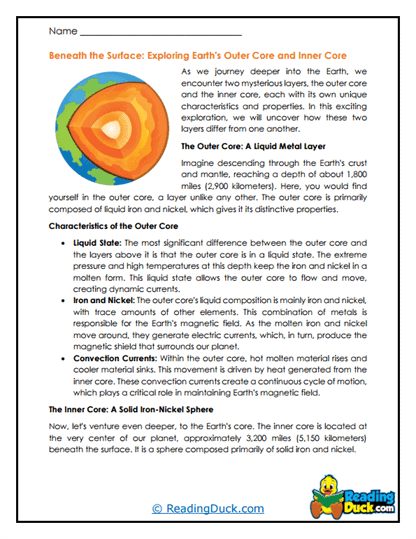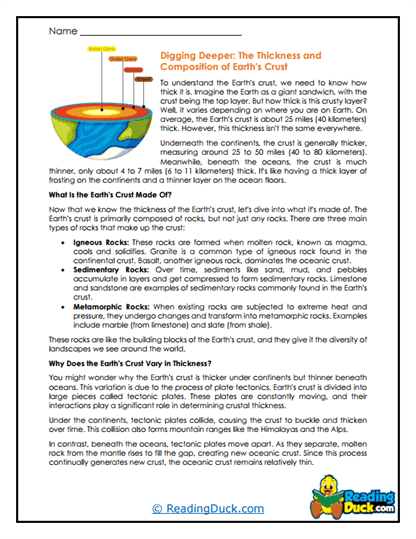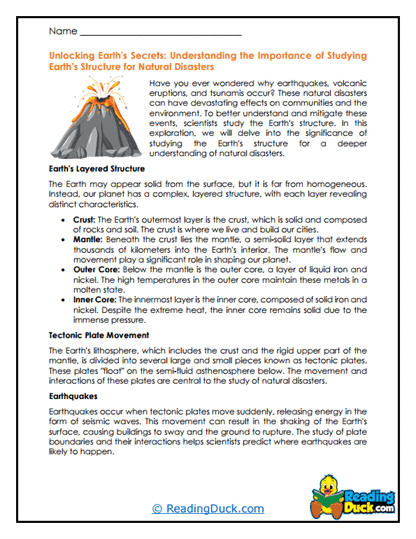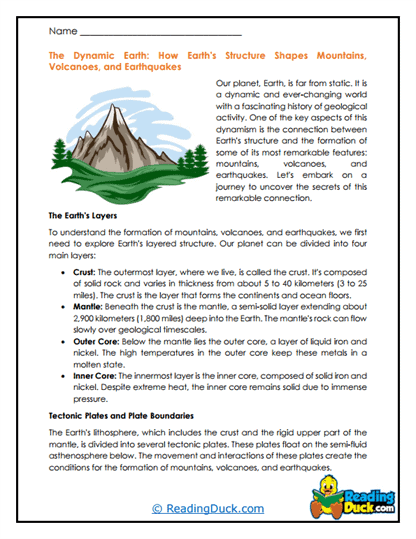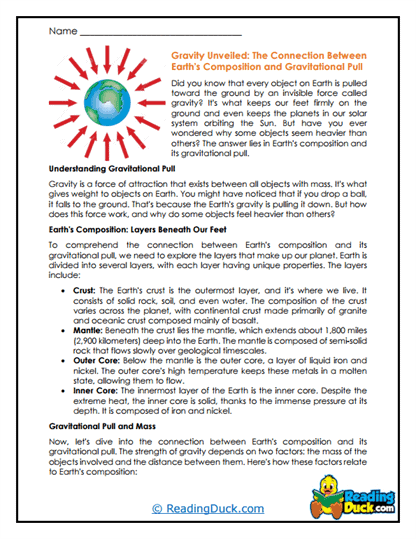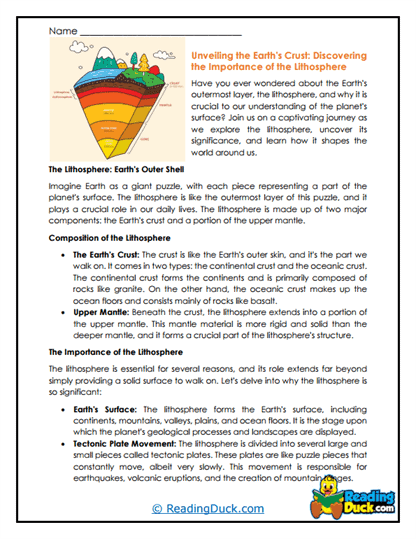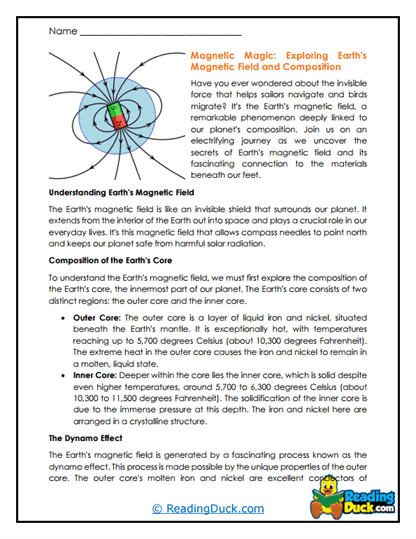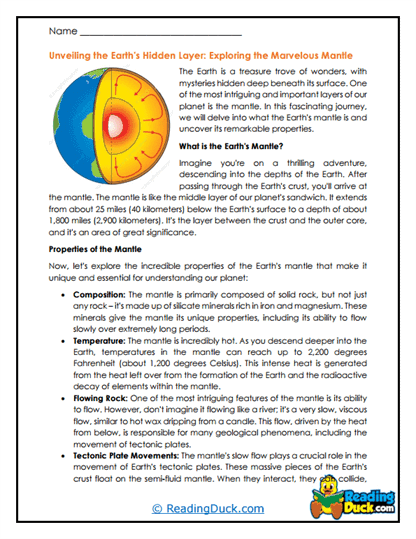Earth's Structure Worksheets
About Our Earth's Structure Worksheets
Our Earth's Structure worksheets provide an in-depth exploration of the various layers and components that make up our planet. As a subtopic within Earth Science, these worksheets are designed to enhance students' understanding of how the Earth is constructed, from its crust to its core. The collection is crafted to engage students with a variety of learning activities that make complex concepts accessible and interesting.
Each worksheet set in this collection includes multiple learning tools to help students grasp the material effectively:
- Multiple Choice Questions: These questions assess students’ comprehension of key concepts such as the Earth's layers, plate tectonics, and the movement of tectonic plates.
- Short Answer Questions: These questions encourage students to explain concepts like the composition of the Earth's mantle or the dynamics of the outer core in their own words.
- Open-Ended Questions: These questions invite students to reflect on the significance of Earth's structure, how it influences the planet's surface, and their personal views on geological phenomena.
Each worksheet is accompanied by an answer key, making it easy for educators and parents to evaluate students' understanding. The worksheets are available in PDF format, ensuring they are easily accessible, downloadable, and printable for use in classrooms or at home.
Understanding Earth’s Structure: Unveiling the Layers of Our Planet
1. The Earth’s Layers: From Crust to Core
- The Crust: The Earth’s Outer Shell
- Continental and Oceanic Crust: The Earth’s crust is its outermost layer, and it’s divided into two types: continental crust and oceanic crust. The continental crust is thicker and less dense, composed mainly of granite, while the oceanic crust is thinner, denser, and primarily composed of basalt. Understanding these differences is crucial for comprehending how tectonic plates interact and shape the Earth’s surface.
- Tectonic Plates: The crust is not a solid shell but is broken into large pieces known as tectonic plates. These plates float on the semi-fluid asthenosphere beneath them and are constantly moving, albeit very slowly. The movement of these plates leads to the formation of mountains, earthquakes, and volcanic activity.
- The Mantle: The Thick Middle Layer
- Composition and Characteristics: Below the crust lies the mantle, which makes up about 84% of the Earth's volume. The mantle is composed of silicate minerals that are rich in iron and magnesium. It’s divided into the upper mantle and the lower mantle, with the upper mantle including the asthenosphere, which allows tectonic plates to move.
- Convection Currents: Within the mantle, convection currents—caused by the heat from the Earth’s core—drive the movement of tectonic plates. These currents are a key factor in the processes of continental drift and plate tectonics, which have shaped the Earth's surface over millions of years.
- The Core: The Earth’s Central Engine
- Outer Core: The outer core is a layer of molten metal, primarily iron and nickel, that surrounds the inner core. The movement of the liquid in the outer core generates the Earth's magnetic field, which protects the planet from harmful solar radiation.
- Inner Core: The inner core is a solid sphere composed mostly of iron and some nickel. Despite its extreme temperatures, the immense pressure at the Earth’s center keeps the inner core in a solid state. The inner core is crucial for maintaining the Earth’s magnetic field and plays a significant role in the planet’s geodynamics.
2. The Dynamic Earth: Understanding Plate Tectonics and Geological Activity
- Plate Tectonics: The Forces That Shape the Earth
- Plate Boundaries: The Earth’s tectonic plates interact at their boundaries, which can be classified into three types: divergent, convergent, and transform boundaries. At divergent boundaries, plates move apart, forming new crust as magma rises from the mantle. At convergent boundaries, plates collide, leading to the formation of mountains, earthquakes, and volcanic activity. Transform boundaries are where plates slide past each other, often causing earthquakes.
- Geological Features: The movement of tectonic plates is responsible for many of Earth’s most dramatic geological features, including mountain ranges, deep ocean trenches, and volcanic arcs. Understanding plate tectonics is essential for explaining the distribution of earthquakes and volcanoes around the world.
- Earthquakes: Shaking the Planet
- Causes of Earthquakes: Earthquakes occur when the stress accumulated along fault lines due to the movement of tectonic plates is suddenly released. This release of energy generates seismic waves that shake the ground. The point within the Earth where the earthquake originates is called the focus, while the point on the Earth’s surface directly above it is the epicenter.
- Measuring Earthquakes: Earthquakes are measured using the Richter scale, which quantifies the magnitude of the seismic waves. Seismographs are the instruments used to record these waves, providing valuable data for scientists to study the Earth’s internal processes.
- Volcanoes: Windows into the Earth’s Interior
- Formation and Types: Volcanoes form at tectonic plate boundaries, particularly at divergent and convergent boundaries, where magma from the mantle reaches the Earth’s surface. There are different types of volcanoes, including shield volcanoes, composite volcanoes, and cinder cone volcanoes, each with distinct shapes and eruption styles.
- Volcanic Eruptions: Volcanic eruptions are powerful events that release ash, gas, and lava. These eruptions can create new landforms, influence global climate, and have significant impacts on human populations. Understanding volcanoes helps us prepare for and mitigate the effects of volcanic activity.
Activities to Supplement These Worksheets
To make the study of Earth’s structure more engaging and to deepen students’ understanding, consider incorporating these activities into your lesson plans. These hands-on and interactive activities will help students connect theoretical knowledge with real-world applications, enhancing their appreciation for Earth Science.
1. Create a 3D Model of Earth’s Layers:
- Objective: Help students visualize and understand the different layers of the Earth.
- Activity: Provide students with materials such as clay, playdough, or foam balls to create a 3D model of the Earth. Students can layer different colors to represent the crust, mantle, outer core, and inner core. This hands-on activity helps students grasp the concept of Earth’s layers and their relative sizes and compositions.
2. Plate Tectonics Puzzle:
- Objective: Demonstrate how tectonic plates move and interact.
- Activity: Use a map of the world’s tectonic plates, cut into pieces like a jigsaw puzzle. Students can work in groups to piece together the map, showing how the plates fit together. Once the puzzle is complete, discuss how the movement of these plates leads to earthquakes, volcanic activity, and the formation of mountains.
3. Simulate an Earthquake:
- Objective: Understand how earthquakes are generated and their effects on structures.
- Activity: Construct a simple shake table using a tray, rubber bands, and marbles. Place small structures made of blocks or cards on the shake table. Simulate an earthquake by shaking the table and observe how the structures respond. This experiment illustrates the impact of seismic waves on buildings and the importance of earthquake-resistant design.
4. Investigate Volcanic Eruptions:
- Objective: Explore the different types of volcanic eruptions and their effects.
- Activity: Create a model volcano using clay or paper-mâché, and simulate an eruption using baking soda, vinegar, and food coloring. Students can experiment with different amounts of baking soda and vinegar to simulate explosive eruptions versus more gentle lava flows. Discuss the different types of volcanoes and the impact of eruptions on the environment and human communities.
5. Map Earthquake and Volcano Locations:
- Objective: Identify the global distribution of earthquakes and volcanoes and their relationship to tectonic plate boundaries.
- Activity: Provide students with a world map and data on recent earthquakes and volcanic eruptions. Have students plot the locations of these events on the map and analyze the patterns. This activity reinforces the concept of plate tectonics and helps students understand the connection between tectonic activity and the distribution of geological hazards.
6. Research a Major Earthquake or Volcanic Eruption:
- Objective: Explore the real-world impact of significant geological events.
- Activity: Assign students to research a major earthquake or volcanic eruption, such as the 1980 eruption of Mount St. Helens or the 2010 Haiti earthquake. Students can create presentations or reports that cover the causes, effects, and responses to these events. This activity connects scientific concepts to historical events and helps students understand the human and environmental consequences of Earth’s dynamic processes.
7. Field Trip to a Geological Site:
- Objective: Provide students with a firsthand experience of Earth’s geological features.
- Activity: Organize a field trip to a local geological site, such as a mountain range, fault line, or volcanic area. If a physical field trip is not possible, consider a virtual field trip using online resources. Students can observe and study geological formations, rock types, and evidence of tectonic activity, reinforcing their classroom learning with real-world observations.
By integrating these activities with our Earth’s Structure worksheets, educators and parents can create a dynamic and interactive learning environment. These activities not only reinforce the concepts covered in the worksheets but also encourage critical thinking, problem-solving, and creativity. They help students understand the fundamental processes that shape our planet, fostering a deeper appreciation for the science of Earth’s structure.
